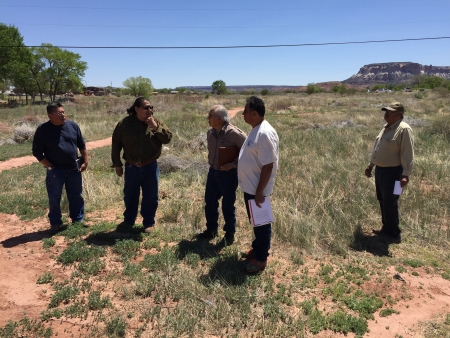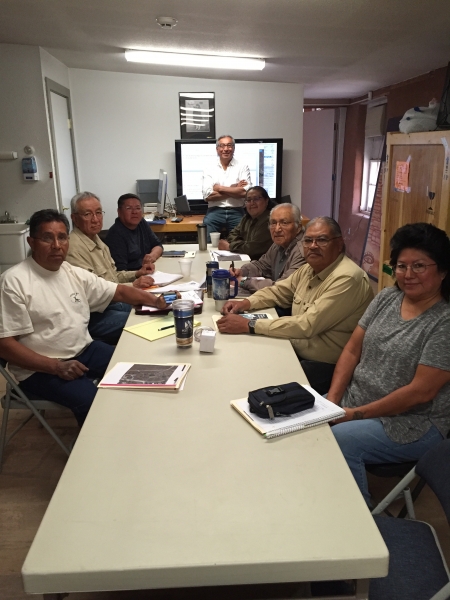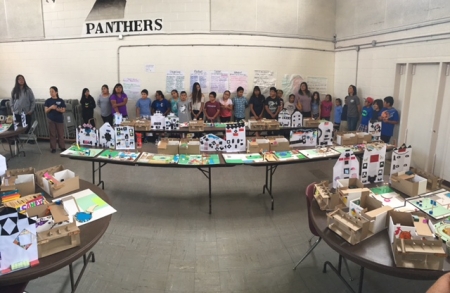ArtPlace America’s Community Development Investments (CDI) program provides funding and technical assistance to community development organizations who haven’t previously had a significant history of working with arts and culture.
The first nine months of the program have been focused on learning core concepts of creative placemaking, undertaking cultural asset mapping activities, and beginning to plan projects with local communities.
We asked each participating organization to reflect on three things they’ve learned at the recent ArtPlace Summit and technical assistance visits, three challenges and opportunities they are currently facing, and three things they’re looking forward to in the future.
For more information about Zuni Youth Enrichment Project, visit their homepage on our website!
Three things you learned at the Summit and on the TA visits:
In addition to providing the chance for us to create a transformational space for our community, the ArtPlace CDI opportunity has been an amazing personal learning experience for all of us at ZYEP. It has changed the way we approach our mission of promoting the mental and physical health of Zuni youth by helping us better see the potential that is right in front of us. The recent Summit and TA visit have been instrumental in this transition.

First, the Summit helped show us the powerful role that art and culture can play in promoting health through bolstering resiliency. I am a pediatrician working on the Zuni Native American Reservation. For years, I have often focused on the direct (and very obvious) approaches of addressing issues such as childhood obesity by creating opportunities for physical activity and nutritional education. Intuitively, I knew that Zuni culture is a critical component of health, but the Summit helped me think more about the basis for this connection. A few weeks after the Summit, I attended an Indian Health Service conference about the health effects of historical trauma on Native communities. It described the direct connections between trauma experienced generations ago, the ongoing trauma inflicted on Native youth in the form of abuse and neglect (often alcohol and drug related), the body’s response to the toxic stress this trauma creates, and the development of mental and physical disease. As I listened to these lectures, I thought back to the ArtPlace Summit, and it struck me that offering a child a chance to play a sport or build a garden is not enough to heal these fundamental wounds. This healing, and therefore the basis of health, comes from things that promote resiliency, which can directly counter the effects of toxic stress. As I reflected on these ideas, I realized the true impact that our CDI project could have on the lives of the Zuni people. Culture and tradition, expressed through art, are fundamental to developing this resilience, especially in a community with such a rich heritage. Our CDI project involves creating a community park in the central village called Hon A:won (translated as “for everyone”). The Summit helped me connect the dots in my head and showed me the direct way in which Zuni art and culture can ensure that the Hon A:won Park’s impact goes far beyond the direct benefits of the activities that occur within its borders.
In addition to helping us better understand the big picture, the TA visit helped us improve many specific aspects of our CDI project as well. One of these insights was the importance of keeping the community updated on the park development and engaged throughout the process. At the outset of our project, we held large community events and worked hard to inform everyone about the coming Hon A:won Park and invite their participation. After a series of community meetings, focus groups, surveys, and workshops, we have been able to hone in on the major priorities of the community. The TA visit helped point out that, as we move towards the less public work of consulting a designer and contractor or setting schedules, we need to remain engaged with the community. This is obviously important as we refine the site design, but it is also critical to maintaining interest, enthusiasm, and a sense of partnership among community members. Two specific ideas from the TA visit that we are implementing include creating a public display (made by a local artist) at the park site, which demonstrates our progress towards opening the park. This display will include milestones and rough dates with a marker indicating how far along we are at any given point. The second idea is to begin programming on the space as soon as possible rather than waiting until construction is finalized. We are hoping to conduct traditional storytelling with circular seating and a fire pit at the site this winter (the traditional time for storytelling in Zuni).
 A third insight from the TA visit and Summit involves the power of networking in creative placemaking. Willy Wong demonstrated the potential of this approach by explaining how his team enhanced the appeal of Paterson Falls National Park by linking the falls to the area’s past as expressed by surrounding restaurants. The campaign was called “Great Falls, Great Food, Great Stories,” and made visiting the national park much more than seeing a waterfall. This example has inspired our commitment to creating networks as we plan the Hon A:won Park. We have initiated conversations with the local cultural museum (A:shiwi A:won Museum and Heritage Center) about developing exhibits that link the park to the museum. We have continued working with the tourism and economic development group (Zuni MainStreet) about holding joint events designed to bring in buyers of Zuni art, and we are planning to hold community athletic events that link the local fitness center with the Hon A:won Park. We are excited about how these and other networks will bring more people into the space and increase the community’s sense of ownership.
A third insight from the TA visit and Summit involves the power of networking in creative placemaking. Willy Wong demonstrated the potential of this approach by explaining how his team enhanced the appeal of Paterson Falls National Park by linking the falls to the area’s past as expressed by surrounding restaurants. The campaign was called “Great Falls, Great Food, Great Stories,” and made visiting the national park much more than seeing a waterfall. This example has inspired our commitment to creating networks as we plan the Hon A:won Park. We have initiated conversations with the local cultural museum (A:shiwi A:won Museum and Heritage Center) about developing exhibits that link the park to the museum. We have continued working with the tourism and economic development group (Zuni MainStreet) about holding joint events designed to bring in buyers of Zuni art, and we are planning to hold community athletic events that link the local fitness center with the Hon A:won Park. We are excited about how these and other networks will bring more people into the space and increase the community’s sense of ownership.
Three new operational challenges (or opportunities!) that were surfaced during or out of the TA visits:
In addition to giving us confidence that we are generally on the right track, the TA visit did highlight some potential stumbling blocks that we need to begin addressing before they limit the impact of our project. First, the site visit helped us look at the challenge of sustainability as an opportunity to more deeply engage the community. We are planning the Hon A:won Park to be as “low maintenance” as possible, but there will be inevitable costs of maintenance and programming. As a non-profit organization that offers our programs free of charge, we are largely dependent on donations and grant funding, which has some inherent uncertainty. During the TA visit we discussed several models for ensuring a steady revenue source to cover the costs of maintenance. Chelina Odbert described how a similar project in Kenya has partnered with local food vendors who sell on the site in exchange for sharing a small percentage of their profits for site maintenance. This helps bring energy to the space while increasing the number of customers available for the vendors, so both parties benefit. We were also very interested in a youth-led bike share program that Chelina described in a community in California. Local youth managed this project of short-term bike rentals, which brought numerous benefits to the community, including youth entrepreneurism, physical activity, and a small source of revenue for the park.
A second potential pitfall identified from the TA visit is that, if we are not careful, the Hon A:won Park could be viewed by the community as a space for ZYEP rather than “for everyone” as the name means in the Zuni language. Our goal is for the space to be a safe, empowering, and inspiring place for everyone in Zuni. If all of the responsibility for planning and programming comes from our organization, however, the community may feel as thought they are guests in the park. To help ensure that this does not happen, it was suggested that we develop a Park Committee that is in charge of the programming that occurs at the space. This committee would consist of a broad representation of committed community members who meet regularly, plan events, and help with the site design. The work of the committee members, including when they meet and how to be a part of the process, would be transparent. We hope this approach will help ensure that everyone has a voice and that new ideas come from the community while also partially relieving ZYEP of some of the responsibility for ongoing programming.

The TA visit also helped us recognize the complexities of working with artists who will contribute to the design of the Hon A:won Park. We have been focused on the positive aspects of providing artists with this opportunity to create public art, enrich their community, and earn a commission. However, there are only a limited number of opportunities for artists, even on a large project. The TA visit helped us think about the need to develop a transparent, fair, and consistent process for selecting artists who will create art on the site. The Zuni Pueblo is a very tight-nit community, which increases the potential for rumors and dissatisfaction among artists if the process is not transparent. We are exploring the idea of creating a fully independent selection board that would make the process as objective as possible. Other similar issues that arose during the TA visit include: how should we credit artists whose ideas are incorporated into the architectural design and how can we use this process to increase the economic development of artists beyond the commission?
Three things you are excited about that are coming up:
It’s hard to think of only three things we are excited about! The optimism and excitement that this CDI opportunity has fostered within our organization has been among the most significant benefits of the project. With this, the first thing we are excited about is the unknown. This experience has taught us that by working hard and staying true to our principles as an organization, amazing things will happen for us and for our community. We are also learning to loosen our grip on the process and trust that, by empowering community members to have more control of the project, it will go in unexpected and wonderful directions. Secondly, we are excited about the potential to re-create a traditional space along the Zuni River. The Hon A:won Park will be located along the Zuni River, which is now a dry riverbed, but for centuries was the lifeblood of Zuni civilization. The park space was once filled with traditional gardens, ovens, and meeting spaces. One objective of the project is to recreate such a space along the river. We hope that this will become a place of cultural pride and education, intergenerational understanding, and productive gardening. Thirdly, we are looking forward to summer evening concerts in the park. Zuni has never had an opportunity like this, but there is great enthusiasm for opportunities like this to come together as a community, enjoy art, each other’s company, and the summer weather.





